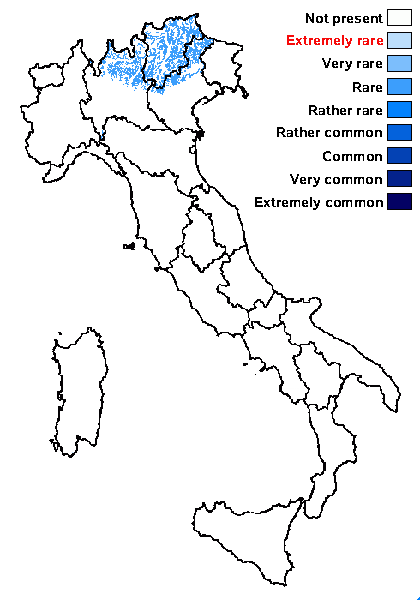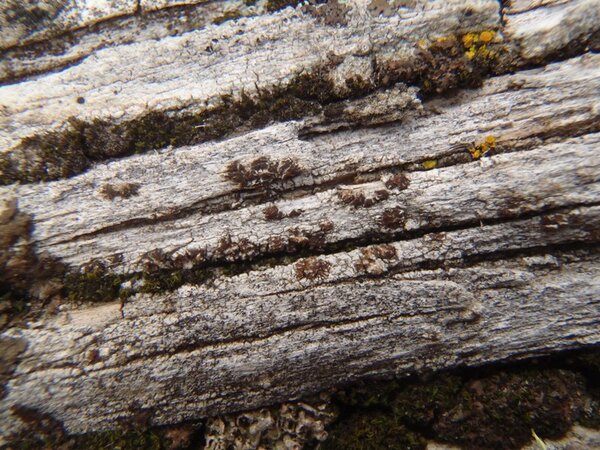Xylographa pallens (Nyl.) Malmgren
Not. Sällsk. Fauna Fl. Fenn. Förh., Ny Ser. 6: 84, 1861. Basionym: Xylographa parallela var. pallens Nyl. - Act. Soc. Linn. Bordeaux, 21: 393, 1857.
Synonyms:
Distribution: N - Ven (Nascimbene & al. 2021), TAA (Spribille & al. 2015), Lomb (Jatta 1909-1911).
Description: Thallus thin, of small, lens-like areoles, sometimes appearing rimose, scurfy, or granular, with 35-90 μm wide, corticate goniocysts. Apothecia linear, 0.5-2.8 x 0.09-0.33 mm, growing linearly in two to many directions, forming star-shaped clusters, with a flat to concave, pale to dark brown, matt disc, and a thin, brownish, finally excluded proper margin. Exciple of laterally interwoven hyphae, appearing paraplectenchymatous in vertical sections, 15-35(-50) μm wide, brown in outer part, colourless within; hymenium colourless to brown, 40-120 μm high, hemiamyloid, I+ blue-green turning rust-red; paraphyses slender, branched and anastomosing, 1.5-2 μm thick at mid-level, the apical cells 4-6 μm thick, continuing laterally in knot-like tangles over surface of disc, with brown wall pigments; hypothecium colourless, 80-140(-200) μm high. Asci 8-spored, clavate-cylindrical, unitunicate, the gelatinous sheaths covering the walls amyloid, the tholus lacking internal amyloid structures, similar to that in Trapelia. Ascospores 1-celled, hyaline, ellipsoid, (10-)12-16(-18.5) x 5-7.5(-10) μm. Pycnidia rare, formed in lines at the periphery of individual thalli, globular to cupular. Conidia filiform, curved, (10-)12–13(-18.5) x c. 0.5 μm. Photobiont chlorococcoid. Spot tests: thallus K+ yellowish (microscopic section!), C-, KC-, P+ yellow. Chemistry: stictic acid (major), norstictic acid (usually trace, rarely major), often with an unidentified fatty acid (trace).Note: a widespread species in the Northern Hemisphere, growing on wood, especially in exposed habitats becoming dry in summer, mainly in montane to subalpine coniferous forests.
Growth form: Crustose
Substrata: lignum
Photobiont: green algae other than Trentepohlia
Reproductive strategy: mainly sexual
Commonnes-rarity: (info)
Alpine belt: absent
Subalpine belt: rare
Oromediterranean belt: absent
Montane belt: rare
Submediterranean belt: absent
Padanian area: absent
Humid submediterranean belt: absent
Humid mediterranean belt: absent
Dry mediterranean belt: absent

Predictive model
Growth form: Crustose
Substrata: lignum
Photobiont: green algae other than Trentepohlia
Reproductive strategy: mainly sexual
Commonnes-rarity: (info)
Alpine belt: absent
Subalpine belt: rare
Oromediterranean belt: absent
Montane belt: rare
Submediterranean belt: absent
Padanian area: absent
Humid submediterranean belt: absent
Humid mediterranean belt: absent
Dry mediterranean belt: absent

Predictive model
 INDEX FUNGORUM
INDEX FUNGORUM
 GBIF
GBIF
 DOLICHENS
DOLICHENS




